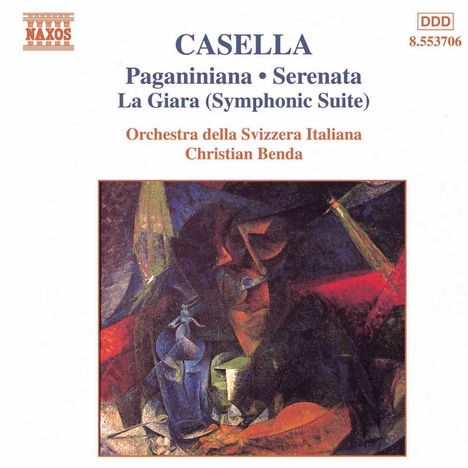Alfredo Casella: Divertimento op.65 "Paganiniana" auf CD
Divertimento op.65 "Paganiniana"
Herkömmliche CD, die mit allen CD-Playern und Computerlaufwerken, aber auch mit den meisten SACD- oder Multiplayern abspielbar ist.
Lassen Sie sich über unseren eCourier benachrichtigen, falls das Produkt bestellt werden kann.
+Serenata op. 46b; La Giara-Suite op. 41b
- Künstler:
- Orchestra della Svizzera Italiana, Christian Benda
- Label:
- Naxos
- Aufnahmejahr ca.:
- 1995
- UPC/EAN:
- 0730099470629
- Erscheinungstermin:
- 4.1.1999
- Serie:
- Naxos 19th/20th Century Italian Classics
Ähnliche Artikel
Casellas Großvater, der Cellist Pietro Casella, war ein enger Freund Paganinis und hatte dessen Sohn Achille unterrichtet. Im Jahr 1942 vollendete Casella ein Divertimento unter dem Titel Paganiniana unter Verwendung von Melodien, die Paganini entliehen wurden, wobei die Melodie, die Brahms, Rachmaninow und anderen so vertraut war, vermieden wurde. Paganiniana, Op. 65, sollte später, 1943, für La rosa del sogno (Die Traumrose) wiederverwendet werden, für die Aurel von Milloss, Ballettdirektor an der Oper Rom, eine Choreographie lieferte, für die das Originalwerk gut geeignet ist. Das Divertimento beginnt mit einem Perpetuum mobile, gefolgt von einer kleinen Polka, einer expressiveren Romanza und einer abschließenden Tarantella. In allen vier Sätzen gibt es etwas von Strawinsky in der Instrumentierung und den chromatischen Veränderungen in der im Grunde genommen immer noch diatonischen Harmonie.
Etwas vom gleichen Idiom zeigt sich in Casellas Serenata op. 46, die innerhalb von sechs Wochen Ende 1927 entstand und seinem damaligen Freund, dem Komponisten und Direktor des Conservatorio di Sta Cecilia in Rom, Giuseppe Mule, gewidmet ist. Ursprünglich für Klarinette, Trompete, Violine und Violoncello komponiert, entstand sie als Antwort auf eine Einladung, die Casella zufällig unter den Papieren auf seinem Schreibtisch entdeckte, und zwar für eine Kammermusikkomposition für drei bis sechs Instrumente als Beitrag zu einem Wettbewerb der Musical Fund Society of Philadelphia. Nachdem er seine Einsendung noch vor Ende des Jahres, dem Einsendeschluss, abgeschickt hatte, vergaß Casella sie dann, freute sich aber, als die Serenata unter den 645 eingereichten Kompositionen den ersten Preis mit Bartóks Drittem Streichquartett teilte. Er arrangierte das Werk anschließend für Kammerorchester.
Product Information
Casella's grandfather, the cellist Pietro Casella, had been a close friend of Paganini and had taught the latter's son Achille. In 1942 Casella completed a Divertimento, under the title Paganiniana, making use of melodies taken from Paganini, while avoiding the melody so familiar for its use by Brahms, Rachmaninov and others. Paganiniana, Op. 65, was later to be re-used for La rosa del sogno (The Dream Rose) in 1943, for which Aurel von Milloss, director of ballet at the Rome Opera, provided choreography for which the original work is well suited. The Divertimento starts with a perpetuum mobile, followed by a little Polka, a more expressive Romanza and a final Tarantella. In all four movements there is something of Stravinsky in the instrumentation and the chromatic alterations in what still remains fundamentally diatonic harmony.
Something of the same idiom is apparent in Casella's Serenata, Op. 46, written in the space of six weeks in late 1927 and dedicated to his then friend, the composer and director of the Rome Conservatorio di Sta Cecilia, Giuseppe Mule. Originally scored for clarinet, trumpet, violin and cello, it was composed in response to an invitation that Casella discovered by chance among the papers on his desk for a chamber composition for between three and six instruments as an entry to a competition by the Musical Fund Society of Philadelphia. Having sent his entry before the end of the year, the closing date, Casella then forgot about it but was delighted when the Serenata, from among the 645 compositions submitted, shared the first prize with Bartók's Third String Quartet. He subsequently arranged the work for chamber orchestra.
Rezensionen
G. Schubert in FonoForum 5/99: "Das blendend aufgelegte Orchestra della Svizzera Italiana spielt schwungvoll - begeisternd und deckt auch noch den latenten italienischen Tonfall der Musik auf: ein gelungenes Plädoyer für den Komponisten, das auf weitere Werke neugierig macht."Disk 1 von 1 (CD)
-
1 Paganiniana, Op. 65: I. Allegro agitato
-
2 Paganiniana, Op. 65: II. Polacchetta: Allegretto moderato
-
3 Paganiniana, Op. 65: Iii. Romanza: Larghetto Cantabile Amoroso
-
4 Paganiniana, Op. 65: IV. Tarantella: Presto molto
-
5 Serenata, Op. 46 (version for orchestra): I. Marcia: Allegro vivace e ritmico
-
6 Serenata, Op. 46 (version for orchestra): II. Notturno: Lento, grave
-
7 Serenata, Op. 46 (Version For Orchestra): Iii. Gavotta: Vivacissimo E Spiritoso
-
8 Serenata, Op. 46 (version for orchestra): IV. Cavatina: Adagio molto e sentimentale ma senza parodia
-
9 Serenata, Op. 46 (version for orchestra): V. Finale: Vivacissimo, alla Napoletana
-
10 La giara Suite, Op. 41bis: Ia. Preludio
-
11 La giara Suite, Op. 41bis: Ib. Chiovu: Danza popolare siciliana
-
12 La giara Suite, Op. 41bis: IIa. "La storia della fanciulla rapita dai pirati"
-
13 La giara Suite, Op. 41bis: IIb. Danza di Nela
-
14 La giara Suite, Op. 41bis: IIc. Entrata dei contadini
-
15 La giara Suite, Op. 41bis: IId. Brindisi
-
16 La giara Suite, Op. 41bis: IIe. Danza generale
-
17 La giara Suite, Op. 41bis: IIf. Finale
Mehr von Alfredo Casella
-
Alfredo CasellaSymphonie Nr.1 op.5CDAktueller Preis: EUR 14,99
-
Alfredo CasellaConcerto Romano f.Orgel & OrchesterCDAktueller Preis: EUR 19,99
-
Alfredo CasellaSämtliche Symphonien2 CDsAktueller Preis: EUR 36,99
-
Alfredo CasellaOrchesterfragmente aus "La Donna serpente" op.50CDAktueller Preis: EUR 14,99











